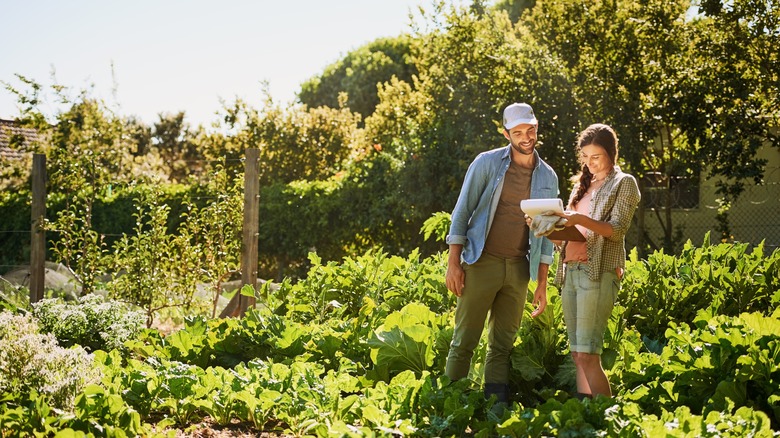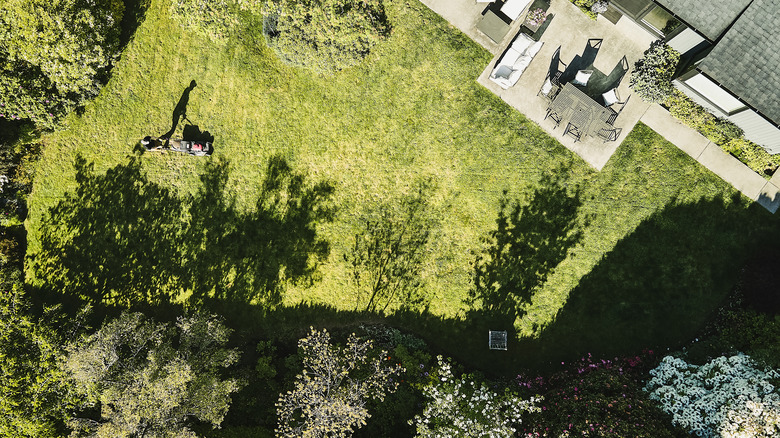Mistakes You're Making When Building A Sun Map
We may receive a commission on purchases made from links.
Pondering how to correctly map out and space your garden veggie plants? Alongside amending the soil so it feeds your plants properly and getting the irrigation system up and running, you need to consider how much sun the plot gets. Vegetables, especially those that flower and fruit, need anywhere between three and eight hours of full sun. Even if you're growing exclusively ornamentals, you've probably noticed nursery plant labels stating full sun, partial shade, and deep shade. This refers to how much sun the plant needs to thrive, and not keel over and die on you weeks or months after you've put it into the ground.
A sun map helps you work out where to put a new garden or plant a particular species in an existing garden, but only if you do it right. Common mistakes gardeners make when putting together a sun map for the first time include tracking sunlight at the wrong time of year or climatic conditions, only focusing on the sun and ignoring shade, and failing to take advantage of the many physical and digital tools designed to make mapping a breeze. Sun maps don't have to be difficult to produce. At the simplest, you can draw a rough bird's eye view of your garden on a piece of paper — it doesn't even have to be to scale — and mark sun lines in different colored pencils or pens corresponding to the time of day you observed the garden, sunrise to sunset. You can transfer the data into an easy-view chart, handwritten or electronic, with the time of day along the top and the areas of your backyard down the left side.
You gather data for your map at the wrong time or in the wrong conditions
Most people garden from spring through fall; it's easy to forget that the strength of sunlight and number of sunshine hours differs between the warmer and cooler months. If you only have the chance (or the patience) to make a couple of sun maps, make one around the spring equinox (April or May) or near the fall equinox (about mid-September) and another in mid-summer — importantly, the trees are leafy and the sun is higher in the sky. If, however, you're a lover of data-driven gardening, your thumb will grow ever-greener with an all-four-seasons sun map, giving you a full year of valuable information on transitional zones — areas that cross between full sun and shade over time — that you can tap into when deciding where to plant what and when.
A year-round sun map is, however, an essential step in starting a backyard winter garden for beginners. Most parts of the world get less sun in winter, so knowing what areas of your garden are in full sun during the chilly months gives you an understanding of, for example, where to set up winter vegetable beds. Time of day matters just as much as time of year. Recording data every one to two hours from 6 a.m. to 8 p.m. is ideal, but at least three to four times evenly spaced within that time window would also work. Choose a day free of distractions and when you'll be home all day. Make sure, too, that the day is bright, sunny, and cloudless; overcast weather reduces the contrast between sun and shade.
You only focus on the sun and ignore the shade
As briefly touched on in the previous section, in most places in the world (outside of locales right near the equator), the parts of your garden in shadow changes throughout the year because the sun is higher in the sky in summer and closer to the horizon in winter. The shadows elongate about 75% in the winter. If you're creating a sun map for a spring garden in winter downtime, take the summer shadow shrinkage into account.
Constructions like sheds, fences, and even your house or neighboring homes might block the sun at certain times of the day. Large trees and shrubs play a big part in shade patterns, too. Evergreens may create shade year round, while deciduous trees may create little to no shade in winter, full shade in summer, and dappled shade in spring and fall. A sun map may indicate which trees you need to prune or remove to light up your garden. Finally, structures you install in your garden, like raised beds or trellises, will create shadows; it's worth creating a new map after any such changes.
Instead of drawing the lines of sunlight on your map, draw the shadow lines — the border between shadow and sunlight — and mark the shadow areas inside them. Use a different colored pen for different times of the day. Note, too, the quality of the shade: Is it deep or dappled? If you discover through sun mapping that far more of your garden is in shade than you thought, rejoice! Knowing where that shade lies is among the essential tips for growing a flourishing shade garden.
You underestimate the usefulness of sun mapping tools
While you can create a sun map using just pen and paper, tools help you dive deeper into the collected data. The first rung on the ladder of sun map tool utilization is creating a code to label the different degrees of shade and sun — for example, simple abbreviations or a numbered scoring system. There are also physical tools you can stick into the ground to help you work out areas of sun and shade across your garden. Place surveyor flags — a pack of 300 Amylove Marking Flags in assorted colors costs about $37 — at shade borders in your garden at the limits, using a different color for each hour of the day or number same-hued flags. At just $13, you could purchase a few of the well-rated Classy Casita 3-in-1 Light Testers for Indoor and Outdoor Plants to use in different spots around your backyard. The popular Luster Leaf 1875 Rapitest Suncalc Sunlight Calculator is also affordable at about $19. However, whether these electronic sunlight calculators with light exposure sensors are better than a handwritten map and personal observation is questionable.
Your smartphone is one of the most useful tools in a digital gardener's arsenal. Take photos of your yard at regular intervals during the day and transfer what you see onto a digital or physical map or table. (You could also use a digital camera on a tripod.) Paid sun mapping apps worth testing out include Sun & Shade Analyzer (SASHA), SunSeeker, FindMyShadow, Sun Surveyor, and the Shadowmap app and website. Sun path tracker SunCalc (linked to Google Maps) is another useful website-only tool worth exploring.



